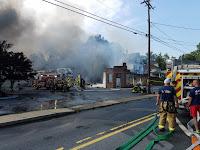Prepare...Prepare...prepare for natural and man-made disasters...and it will pay off when disaster strikes, and strike it will.
We just had a major fire in Mount Airy. A huge warehouse went up...fast.
As with any disaster, there were many lessons to be learned from this event.
Here, I would like to note an oft overlooked prep that worked very well...the creation and signing of Memorandum of Understanding (MOA) with businesses that we invoked for the fire.
We had MOA in place with several local business that we called on for supplies during the fire.
They delivered the supplies and things went much more smoothly due to that fact.
The Importance of Private Sector and Local Government MOA’s
Most emergency managers know about government to
government memorandums of understanding (MOAs) that often include a mutual aid
agreement. But what is often more critical is a memorandum of understanding
between private sector companies (Wal Mart, Ace Hardware, tree service and
debris removal companies, for example) and a local government.
Why?
Because when a disaster strikes, before first
responders can get to the place where people are hurt, dying or disoriented,
trees, cars and debris must be cut out of the way. Who can complete that task?
A skilled construction worker who knows how to cut
through trees, cars and debris can. And how do you know what that person is and
how to reach them?
Well, if you have a signed MOA in place with them,
it is a matter of calling them and getting them on site to aid the recovery
effort in the first critical 72 hours.
Now that social media is such an important part of
our daily reality, you should incorporate that fact in the MOA. For example,
include a space for everyone’s Facebook address and Twitter name address so you
can communicate with them in those media in addition to the usual cell phone
and email address.
I include a MOA template I created a few years ago
for the Town of Mt. Airy where I live. I encourage you to get going on your MOA
as soon as you can. In my experience, I had to go through the Town Council and
their lawyer. Both added several years (not months) to the process.
The town lawyer likes “Whereas” and other archaic
clauses that added pages and text and took a long time to rewrite. I like plain
English, but the reality is that this is a legal document and the lawyers will
have their say. They try to cover every contingency. Any disaster has multiple
unknown contingencies, but they go about their work diligently hoping to
protect the town from everything. It’s just the way it is.
Eventually, the local Town Council gave the MOA its
approval. The Town Administrator and I identified numerous local businesses
with whom we wanted to sign one. They were Wal Mart, Ace Hardware, two local
tree removal companies (skilled construction workers), some local groceries,
and the local utility. We signed a MOA with them and have it in place if and
when an emergency hits.
This is a basic step that you can take to ameliorate
problems before an event strikes. There are so many unknowns that add to any
disaster. This is one positive step you can take to prepare the supplies,
people, and expertise you will need to get through.
We offer several pages from our MOA in hopes it
helps provide you with a template you can adapt and use in your local
situation. Although it takes time, effort, and grit to get it written, approved
and signed, it is well worth it. When you are hit, it can be the difference
between frustration and action in the first critical 72 hours.
TOWN OF [Name]
[State]
AND EMERGENCY CONTRACTOR
MEMORANDUM OF
UNDERSTANDING
Town of [Name]
Emergency Contacts:
Mayor [Name, Phone,
Email, Twitter]
Town Administrator [Name,
Phone, Email, Twitter]
Town Engineer [Name,
Phone, Email, Twitter]
Director of Public
Works [Name, Phone, Email, Twitter]
MEMORANDUM OF
UNDERSTANDING
This
Memorandum of Understanding ("MOU") is entered into this (Date), between (Vendor or Contractor ______________________________________________________,
(hereinafter referred to as “Vendor”), and the Town , Maryland
(hereinafter referred to as “Town”).
2.
Vendor agrees to provide to the Town without advance
payment the following equipment, goods, materials and/or services on an
emergency basis needed to respond to an emergency or disaster:
Item(s) or Services
3. The Vendor will thereafter promptly
submit to the Town adequate documentation for the cost of goods and/or services
provided. The Town agrees to reimburse Vendor the fair market price for such
goods and/or services acquired and utilized by the Town to respond to the
emergency. The Town shall promptly return to Vendor any such goods or materials
that the Town did not utilize in substantially the same condition as such was
received. The Town will reimburse Vendor the reasonable price of any such goods
or materials even if not utilized to respond to the emergency if not promptly
returned to Vendor in substantially the same condition as was received by the
Town. In no event will the Town be responsible to reimburse Vendor for any
goods or materials, although initially acquired by the Town to respond to the
emergency or disaster, but which is promptly returned to Vendor in
substantially the same condition as such was received by the Town.
4. Nothing contained herein shall be construed
to bind the Town to procure the goods and/or services outlined herein or to
provide such to any area within the Town or outside the Town limits even in the
event of an emergency.
5. Nothing contained herein shall be construed
to provide an exclusive right on the part of Vendor to supply materials, goods
or services to the Town. It is expressly acknowledged that the Town has or may
enter into similar MOUs with other vendors for identical or like goods and/or
services and that the Town pursuant to any such Memoranda shall have complete
discretion on determining from which vendors to obtain any such goods and/or
services.
6. The parties agree to comply with all federal,
state, and local laws and regulations during an emergency of disaster.
7. This MOU is
effective on [Date] unless modified in writing before that date. This MOU
shall automatically renew for an additional 24 months.at the end of the initial
term and upon the same terms and conditions as set forth herein, unless, at
least 180 days prior to the end of the initial term, either Party provides the
other Party with written notification of its intent not to renew.
8. This MOU may be terminated by either party
upon thirty (30) days written notice. Termination of this MOU shall not relieve
the terminating party from any obligations assumed prior to the effective date
of termination.9. The following persons shall serve as the
contact persons for any issues related to this MOU (please supply both regular
and after hour contact information).
c. Each Party will make certain
that it has an updated list of staff contacts to facilitate communication and
to resolve issues as they may arise.d. Each Party agrees to assign
appropriate staff to serve as a single point of contact should any personnel
changes occur.e. All notices shall be sent to
the addresses set forth below:
Town: [Mayor
Name}
[Town Hall
Address]
Vendor/Service Contact Information (complete all that apply):
Business/Service Name: ________________________________________
Business/Service Contact: _______________________________________
Address: _____________________________________________________
Email: _______________________________________________________
Phone: ________________________________________________________
Fax: _________________________________________________________
Website: ______________________________________________________
Facebook Page: ________________________________________________
Twitter Name:
_________________________________________________
10. This MOU shall be governed and interpreted
under the laws of the State of [Name].
11. This MOU may
be amended only with the written consent of both Parties. Amendments may not
change significantly the scope of this Agreement.
12. Neither Party assumes liability for the acts or
omissions of the other party or its agents. Nothing in this MOU shall be
construed to extend the immunities of one Party and its agents to the other
Party or its agents.
13. Neither Party may assign any rights or interests nor
delegate its duties under this MOU, in whole or in part, without the express
prior written permission of the other Party. Without such written permission,
any attempted assignment or delegation shall be wholly void and totally
ineffective for all purposes.
14. A waiver by any Party of any breach or default by the
other Party under this MO shall not constitute a continuing waiver by such Party
of any subsequent act in breach of or in default hereunder.
15. This MOU signed by all Parties
constitutes a final written expression of all terms of this MOU and is a
complete and exclusive statement of those terms.
16. This MOU contains the entire agreement
between the Parties hereto and shall not be modified, amended or supplemented,
or any rights herein waived, unless specifically agreed upon in writing by the
parties hereto. This MOU supersedes any and all previous agreements, whether
written or oral, between the parties.
IN WITNESS WHEREOF, the
parties have executed this MOU on the date set forth above.
By: [Mayor’s Name]
[Email]
[Phone #]
__________________________________________
By:
________________________________________
Title:
_________________________________________
Vendor/Service:
Have your MOA's up-to-date, signed, and ready.Here are some photos and videos of the fire and its aftermath.
Have your MOA's up-to-date, signed, and ready.Here are some photos and videos of the fire and its aftermath.









































